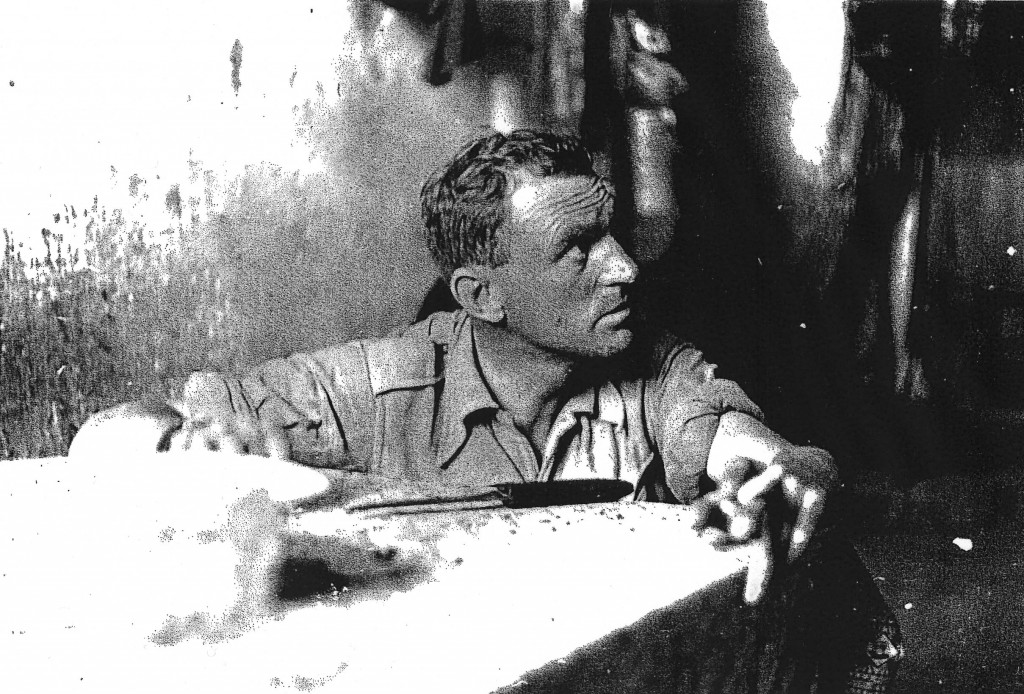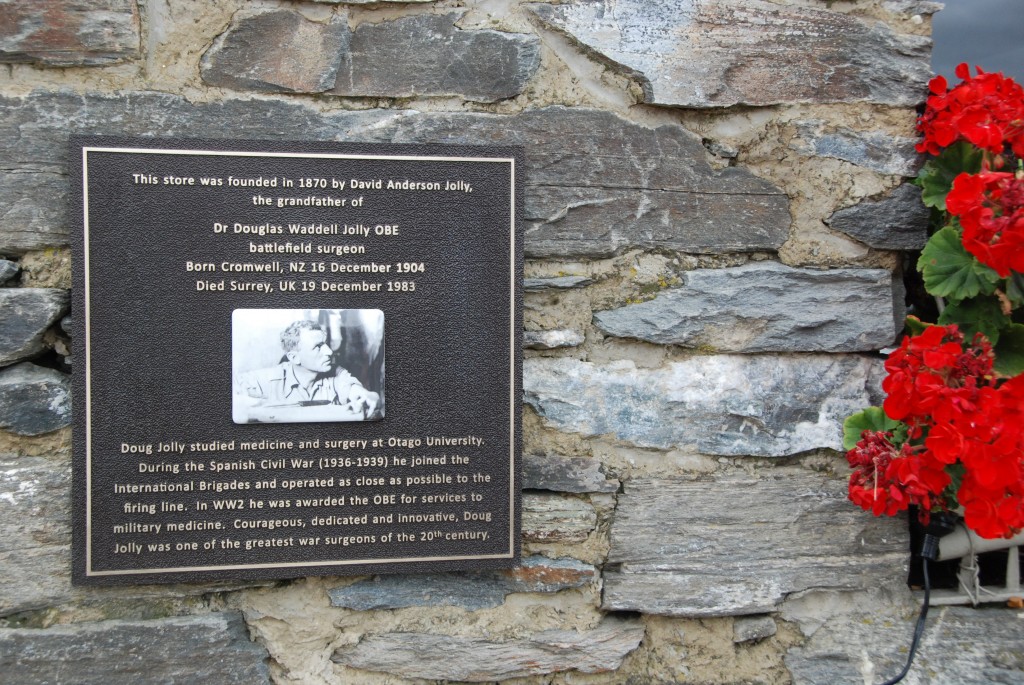Doug Jolly: New Zealand Surgeon in Spain
Doug Jolly, a New Zealand-born surgeon who served with the Spanish Republican Army’s medical services during the civil war has been posthumously honored in his home town.
In March 2018 a quiet and moving ceremony took place on the shores of Lake Dunstan in Central Otago, New Zealand. Overlooking the lake is Jolly’s Grain and Feed Store, built in 1870 by David Jolly to serve the goldrush settlement of Cromwell. The handsome stone building now bears a plaque honoring Jolly’s grandson Doug, the outstanding battlefield surgeon. Many of the innovations he helped introduce to the Republican Army’s medical services remained in use in modified form during World War II, and in the Korean and Vietnam Wars.
Doug Jolly gained a medical degree at Otago University, left for London to qualify as a surgeon, and shortly before graduating, went to Spain as part of a British universities’ medical unit. In December 1936, during the Battle of Madrid, he was given the rank of lieutenant in the Republican Army and instructed to form a 50-bed surgical unit, the first international medical unit to go into action in the civil war. His earliest field hospitals were located in vacant farmhouses close to the front line, but out of range of heavy artillery. As enemy air raids increased, the hospitals were based in camouflaged tents, and later in railway tunnels and natural caves.
Jolly and his multinational, polyglot team were posted to wherever the fighting was fiercest. British nurse Penny Feiwel considered him “one of the best surgeons I had ever worked with – and certainly one of the quickest… Jolly worked the whole afternoon, right through the night, the next day, and most of the following night as well, practically without a break. He never seemed to tire or lose his concentration.”
Jolly and his multinational team were posted to wherever the fighting was fiercest.
Another nurse said of him that “a man more ‘Jolly’ would be difficult to find. I remember once, waiting an order to leave for the front, all of us nervous and tense, fearful that planes would arrive… Dr Jolly began to tell jokes and, seeing that the Spaniards did not understand him, began to dance and sing in the style of the Maoris… all were smiling and the tension went down.”
Among Jolly’s US colleagues were assistant surgeon Franklin Bissell, nurse Irene Goldin, autochir driver Joe Coomes (who died of carbon monoxide poisoning when he slept inside his vehicle one very cold night), and Coomes’ replacement driver Robert Webster. Jolly later recalled “an American (merchant seaman I think) who was with me at Guadalajara in early 1937 and elsewhere. The only name I remember was Topsy. He looked after our (emergency) electric generator and helped with motor transport. He was indefatigable and well-beloved by us all. I have no idea what became of him. Brave as a lion.”
Jolly’s US patients included Robert Colodny, whom he treated for a gunshot wound to the head, and who lived to become a distinguished professor of history at the University of Pittsburgh. During the retreat across the Ebro River, Jolly and his team spent a night in a villa on the Reus Road with Ernest Hemingway.
Jolly’s US patients included Robert Colodny, whom he treated for a gunshot wound to the head.
In his two years in Spain Doug Jolly performed more than 2,000 abdominal operations, and greatly contributed to developing techniques and systems for treating the victims of an entirely new form of mechanized warfare. These included the treatment of fractures with extensive plaster of paris, the introduction of field blood transfusion units, and the use of mobile surgical units known as autochirs. He was later described by his British colleague Dr. Archie Cochrane as “the most valuable volunteer to come from the British Commonwealth.”
Along with all other foreign volunteers, Jolly was withdrawn from the conflict in late 1938. He campaigned for the Republican cause in both Britain and New Zealand, and on the outbreak of World War II returned to the UK. At lightning speed he wrote a medical manual, Field Surgery in Total War, which summarized many of the lessons he and his medical colleagues had learned in Spain. It remained influential for the next 25 years.
Jolly served as a lieutenant-colonel with the Royal Army Medical Corps, earning a military OBE for his services in the Middle East and the Mediterranean. A 1945 letter from his commanding officer indicates his contributions to battlefield surgery during the war:
You have:
Developed the two-stage concept of wound treatment to a truly astonishing level of success
Perfected the use of penicillin and established its role in the treatment of war wounds
Reduced mortality and morbidity for most types of war wounds to a level rarely equaled and never surpassed in any campaign in history…
It will of course be for the historian to assess the worth of your contributions in relation to advances in all theatres of war but I am confident… that the record of your fine work will find a prominent and permanent place in the archives of war surgery.
That final prediction proved greatly premature. In the postwar period Jolly ceased practicing surgery and his innovations in trauma treatment and rehabilitation were largely forgotten. He remained working in England, eventually as chief medical officer of Britain’s largest limb-fitting hospital, and died there in 1983.
Twenty years later, several factors contributed to the restoration of his status as an internationally significant medical pioneer and humanitarian. A retired New Zealand orthopaedic surgeon, Patrick Medlicott, began promoting the idea of a memorial to Jolly in his home town. Another New Zealand doctor, intensive care specialist David Lowe, discovered an extraordinary cache of Jolly’s personal papers in the possession of his step-grand-daughter, Bidda Jones, in Canberra, Australia. In April 2018, Dr. Lowe visited the Tamiment Library, NY University, to search the archive on Spanish Civil War medical services created by US nurse Fredericka Martin. During the 1960s and 70s she contacted many civil war veterans, including Doug Jolly, and established what Lowe describes as “an amazing resource due to the efforts of one person.”
These independent efforts came together and resulted in the project to install the plaque in Cromwell in March of this year. This was unveiled at a ceremony attended by local mayor Tim Cadogan, acting Spanish Ambassador to NZ Sr. Vicente Mas Taladriz, and many of Jolly’s relatives from around the country. His niece, Barbara Jolly, recalled the warmhearted, hospitable and unassuming man she often visited in London. She credited her uncle’s example for her decision to become an operating theatre nurse, a profession she followed for half a century.
With the placing of this plaque, Doug Jolly has in some sense returned permanently to the home he left in the 1930s. However, work continues to ensure that his contribution to military medicine and civilian trauma care is fully recorded and recognized. A full-length biography, commissioned by the University of Nebraska Press, will draw on the lifelong personal archive preserved by Bidda Jones, supplemented by archival research in several countries.
Several speakers at the unveiling noted disturbing similarities between present-day geopolitical conditions and those which led to the civil war and urged those present to follow Doug Jolly’s example. Although a dedicated and humane physician who insisted on treating enemy wounded on the same terms as his own troops and allies, he was also a committed antifascist and told a New Zealand newspaper, “My sympathies were completely with the [Spanish Republican] Government; that was why I went to Spain, and I saw nothing there which altered my mind.”
Mark Derby is a New Zealand historian, and the author of several books on New Zealanders in the Spanish Civil War.
Information and contacts for Doug Jolly’s biography are welcomed and should be sent to David Lowe – David.Lowe@svha.org.au















Thank you for this excellent summary.
I am a retired Military Surgeon, formerly Defence Consultant Advisor in Trauma & Orthopaedics to HM Armed Forces. I am also an amateur military medical historian researching a book, which I hope to produce on War Surgery 1936 – 1945. I aspire to bring to public attention the very great work undertaken by inspirational allied military surgeons of the time, such as Douglas Jolly, and also something of their personalities.
Best wishes
Colonel(Retd)Michael P.M.Stewart, CBE, QHS, FRCSTr&Orth, FRCSEd(AdHom)L/RAMC
What a fantastic biography.
He deserves a street whith his name in Spain,
Like so many other “brigadistas”
Thanks to all of them!
¡Salud y republica!